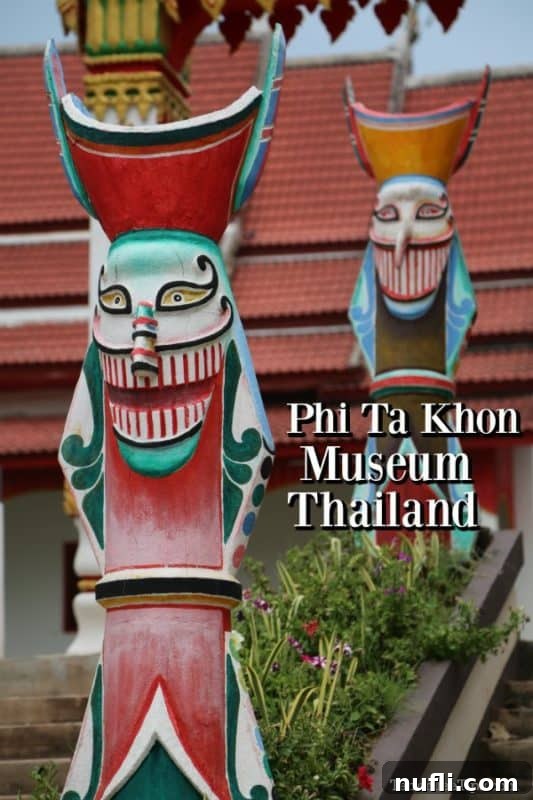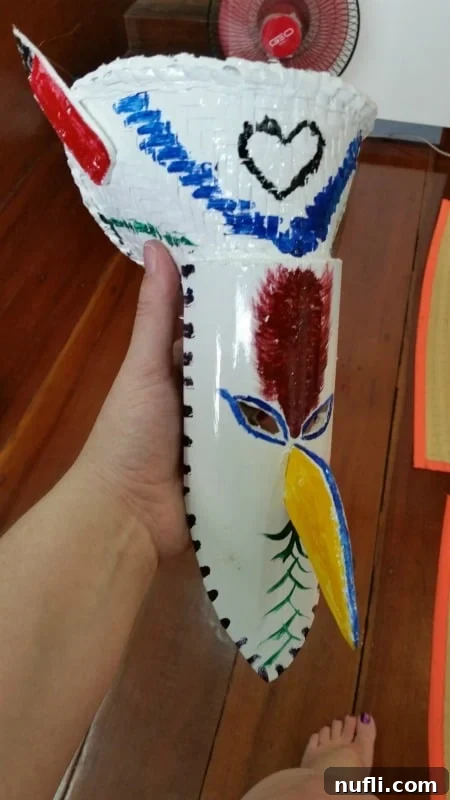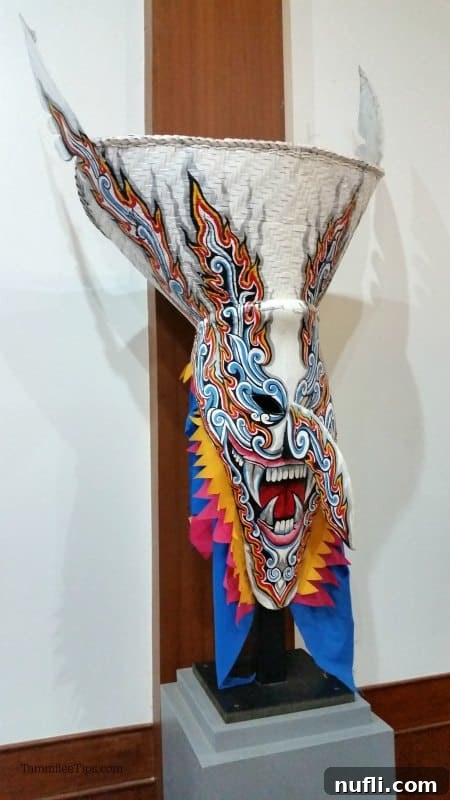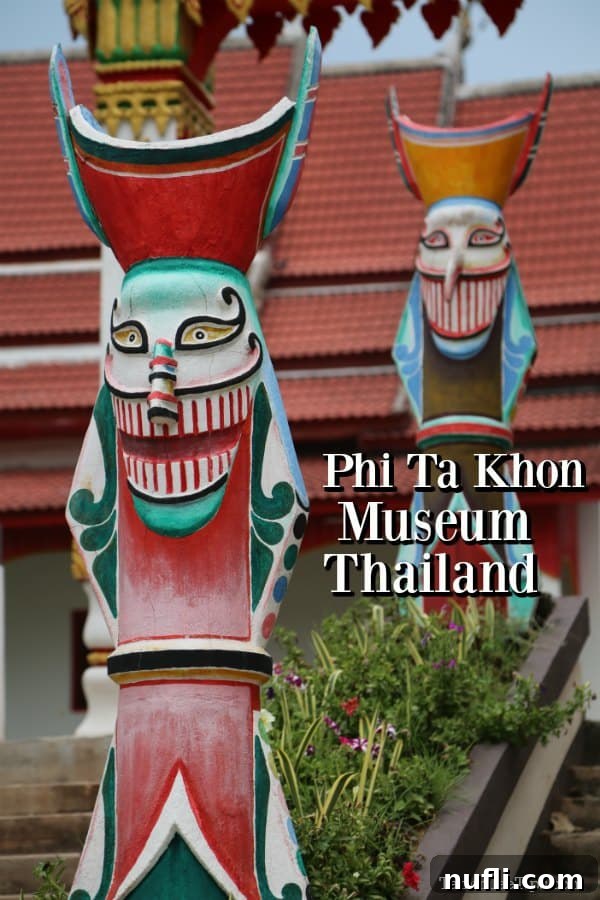Discover the Enigmatic Phi Ta Khon Ghost Masks: A Unique Cultural Journey in Thailand’s Loei Province
Imagine embarking on a journey to Thailand, a land renowned for its vibrant culture and ancient traditions, only to be told your next adventure involves creating a “Ghost Mask.” What springs to mind? For many, the concept of a “ghost mask” might evoke images of the eerie or the macabre. Yet, in the heart of Thailand’s tranquil Loei Province, lies a tradition that transforms this intriguing concept into an explosion of color, folklore, and profound spiritual meaning: the Phi Ta Khon festival and its iconic ghost masks.
My own encounter with this unique cultural art form began with a blend of curiosity and apprehension. As our group traveled through the picturesque landscapes of Loei, the mystery of what exactly a “ghost mask” entailed lingered in the air. We were bound for the Phi Ta Khon Museum, a place dedicated to preserving and celebrating this ancient tradition, where we would not only learn about these masks but also try our hand at painting one. The journey promised an authentic immersion into a lesser-known, yet incredibly rich, facet of Thai heritage, far removed from the typical tourist trails.

Planning Your Phi Ta Khon Adventure? Here are some quick resources:
🏨 Find the Best Hotels and Vacation Rentals in Thailand
📍 Book Unique Tours and Experiences Across Thailand
Stepping into the World of Phi Ta Khon at the Museum
As we neared the Phi Ta Khon Museum, our guide began to point out statues of these distinctive ghost masks along the roadside. Each one, a vibrant spectacle of color and form, offered a tantalizing glimpse into the artistry we were about to encounter. My initial wonder quickly morphed into a slight panic. These weren’t just simple masks; they were intricate, expressive works of folk art, each telling a story through its design and demanding a level of skill I certainly didn’t possess. As someone whose artistic talents unfortunately didn’t extend beyond rudimentary stick figures, the idea of painting one felt daunting. My grandmother, a gifted painter, would have excelled, but alas, her artistic gene seemed to have skipped a generation when it came to me.
Upon entering the museum, we were immediately enveloped in the rich history and cultural significance of the Phi Ta Khon festival. The exhibits skillfully showcased the evolution of the masks, the diverse materials used in their creation – often incorporating natural elements like carved wood and sticky rice husks – and the elaborate rituals associated with the celebration. The museum itself is a treasure trove of information, employing visual displays, historical artifacts, and detailed explanations to illuminate this fascinating tradition. It beautifully captures the spirit of the festival, with numerous photographs illustrating the lively parades and vibrant gatherings during the actual event, providing invaluable context to the artistry we were about to attempt.

My Attempt at Mask Artistry: A Humorous Challenge
Soon, it was our turn. Each of us was presented with a blank, unpainted Phi Ta Khon mask, a pristine canvas awaiting transformation. Staring at the smooth, white surface, devoid of any character, my artistic anxiety peaked. Knowing my limitations with intricate details, I decided to embrace a bolder approach: broad strokes and vivid, unapologetic colors. My mask might not feature the delicate patterns or nuanced expressions of the masterpieces displayed around us, but it would certainly be unique – a testament to my “pre-school” painting style. The aim, I quickly decided, was less about perfection and more about participation and embodying the joyous spirit of the festival.
Despite my self-deprecating assessment of my artistic prowess, the experience of painting the ghost mask was undeniably enjoyable. It transformed into a wonderfully lighthearted and bonding activity for our group of writers. We found ourselves sprawled across a cool wooden floor – a welcome reprieve from Thailand’s characteristically warm and humid air, especially without the benefit of air conditioning. Laughter filled the room as we each wrestled with our artistic visions, sharing tips (or more accurately, commiserating over our challenges) and marveling at each other’s distinct interpretations. It was a moment of pure, unadulterated fun, proving that the joy of creation, even if imperfect, often outweighs the pursuit of perfection, especially when shared with good company.

Witnessing True Mastery: The Art of the Phi Ta Khon Mask
While we enthusiastically (and perhaps clumsily) applied paint to our masks, we had the incredible opportunity to observe a true master artist at work. His hands moved with an almost hypnotic grace, meticulously crafting intricate details onto a mask with breathtaking precision. Every brushstroke was deliberate, every color choice intentional, building layers of expression and cultural symbolism that spoke volumes. The transformation from a simple wooden form to a living, breathing character was mesmerizing. Witnessing the hours of dedication, the steady hand, and the profound artistic skill that go into creating just one of these magnificent masks was awe-inspiring. It underscored the rich, intricate artistic heritage embedded within the Phi Ta Khon tradition and made us appreciate the beauty of the museum’s collection – and the local culture – even more deeply.

The Vibrant Spectacle of the Phi Ta Khon Festival: A Blend of Buddhism and Folklore
The Phi Ta Khon festival, often referred to as the “Ghost Festival” or “Mask Festival,” is far more than just a colorful spectacle; it is a deeply rooted cultural and spiritual event celebrated primarily in the districts of Amphoe Dan Sai and Amphoe Na Haeo in Thailand’s Loei Province. This extraordinary festival beautifully intertwines ancient Buddhist beliefs with local animistic traditions, particularly the reverence for ancestor spirits. It’s an annual event that typically takes place over three days in June or July, though the exact dates are determined by local mediums based on the lunar calendar and can vary from year to year, adding to its mystical allure and requiring advanced planning for visitors.
Unraveling the Festival’s Narrative and Rituals
The origins of Phi Ta Khon are steeped in local folklore, believed to recount a story from the Vessantara Jataka, a traditional Buddhist tale of the Buddha’s penultimate incarnation. According to legend, when Prince Vessantara returned to his city after a long exile, his joyous procession was so grand and boisterous that it was believed to awaken both living and dead spirits from the forest, who then eagerly joined the celebrations. The “Phi Ta Khon” masks, with their often exaggerated features and vibrant designs, represent these spirits, both benevolent and mischievous, who emerge to participate in the revelry. The festival serves as a vibrant reenactment of this legendary procession, celebrating themes of fertility, protection from evil, and community solidarity, all while honoring both the spiritual and agricultural cycles of life.
The festival unfolds over three distinct days, each with its own significant rituals and cultural performances:
- Day One: The Sacred Procession of Phra Upakhut
The first day commences with the solemn yet vibrant Phra Upakhut procession. This revered ritual involves villagers and monks walking from the Man River to Wat Phon Chai, the main temple, to invite Phra Upakhut, a legendary monk who is believed to protect the waters, to safeguard the festival. This act is believed to ensure abundant rainfall for the upcoming rice farming season, highlighting the festival’s deep connection to agrarian life and prosperity. Participants often carry wooden phalluses, a traditional symbol of fertility and good harvest, further emphasizing the themes of abundance and life-giving power. - Day Two: The Grand Parade and Ritual Offerings
On the second day, the heart of the festival truly awakens as the spirited parade, known as “Wan Ruam,” enters the town of Dan Sai. Thousands of participants, predominantly young men, adorn themselves in elaborate and often humorous Phi Ta Khon masks, meticulously crafted from carved wood, sticky rice husks, and vibrant colors. Their costumes, often made from patchwork fabric, are complemented by long wooden phallus-shaped instruments and cowbells, which they rattle noisily to attract attention and ward off negativity. This procession is characterized by exuberant dancing, playful interactions with spectators, mock battles, and a lively atmosphere designed to entertain and symbolically cleanse the community. Later in the day, as a symbolic act of purification and renewal, the Phi Ta Khon participants throw their costumes and accessories into the Man River, signifying the departure of the spirits and the cleansing of ill fortune, leaving behind only blessings for the year ahead. - Day Three: The Great Birth Sermon
The third and final day shifts to a more reflective and spiritual tone. The community gathers for a series of all 13 chapters of the “Great Birth Sermon” (Phra Wet San Don), which is recited by local monks at Wat Phon Chai. This sermon, central to Thai Buddhism, narrates the inspiring story of Prince Vessantara’s unparalleled generosity and self-sacrifice, reinforcing the festival’s spiritual foundations and providing profound moral lessons to the community on compassion, charity, and detachment.


Experience the Authenticity: Why Visit Loei for Phi Ta Khon?
The Phi Ta Khon festival is a testament to Thailand’s enduring cultural richness, offering a truly unique and immersive experience unlike any other. It stands as a powerful expression of community, creativity, and faith, drawing visitors into a world where ancient legends come alive through vibrant performance and deeply held spiritual beliefs. Beyond the festival itself, the Loei Province, often affectionately called “the city of beautiful mountains,” offers a serene escape from the bustling tourist hubs, providing a refreshing glimpse into authentic rural Thai life, characterized by lush landscapes, cool climates, and a welcoming local community.
Planning Your Trip to Loei and Dan Sai for an Unforgettable Experience
For those eager to dive into this extraordinary cultural gem, here’s what you need to know:
- Best Time to Visit: To experience the Phi Ta Khon festival in all its glory, plan your visit for late June or early July. However, since the exact dates are determined annually by local mediums based on the lunar calendar, it’s crucial to check official tourism boards or local news outlets well in advance of your trip. Even outside of festival dates, the Phi Ta Khon Museum in Dan Sai remains a fantastic place to learn about this tradition and appreciate the artistry year-round.
- Getting There: Loei Province is conveniently accessible by domestic flights from Bangkok to Loei Airport (LOEI), with flights typically taking just over an hour. From Loei Airport, you can easily take a local bus or taxi to Dan Sai, which is approximately 80 kilometers away and a scenic drive through the countryside. Alternatively, comfortable overnight buses run regularly from Bangkok to Loei, offering a budget-friendly option.
- Accommodation: While Dan Sai itself has more modest guesthouses and boutique resorts, Loei city offers a wider range of hotels to suit various preferences and budgets. Booking your accommodation well in advance, especially if your visit coincides with the festival, is highly recommended as rooms fill up quickly due to the festival’s popularity.
- Beyond the Masks: Loei Province boasts stunning natural beauty and other cultural attractions. Nature lovers can explore Phu Kradueng National Park for challenging treks and breathtaking views, or Phu Ruea National Park, known for its cool climate, winter flowers, and local vineyards. Additionally, the region is home to numerous tranquil Buddhist temples and charming local markets. Don’t miss the opportunity to visit the Thai Dam Cultural Village near Loei, which offers another fascinating insight into the unique traditions and lifestyle of local ethnic communities.
Conclusion: A Journey into Thailand’s Soul
My journey to the Phi Ta Khon Museum and my humorous attempt at painting a ghost mask offered far more than just a creative endeavor; it was a profound immersion into the soul of Thai culture. It illuminated the intricate tapestry of beliefs, artistry, and community that defines the Phi Ta Khon festival. From the initial mystification surrounding the “ghost masks” to the joyful, if clumsy, act of creation, and finally, to understanding the deep spiritual roots and vibrant celebratory nature of this unique tradition, the entire experience was truly unforgettable. It’s a testament to Thailand’s ability to surprise and enchant, revealing layers of heritage that captivate the imagination.
For any traveler seeking an authentic, colorful, and spiritually rich encounter in Thailand, venturing to Loei Province to explore the Phi Ta Khon tradition is an absolute must. It’s a powerful reminder that Thailand’s charm extends far beyond its famous beaches and bustling cities, inviting you to discover a world where ancient spirits dance alongside lively villagers, and every mask tells a story waiting to be heard. Embrace the opportunity to step off the beaten path and uncover the magic of this extraordinary Thai festival.
Explore More of Thailand: Essential Travel Guides
Deepen your exploration of Thailand’s wonders with these handpicked guides and resources for unforgettable experiences:
- Discover Wat Pho and the Majestic Reclining Buddha in Bangkok
- Visit Wat Arun: The Temple of Dawn, an Iconic Landmark in Bangkok
- Indulge in Luxury: A Dream Visit to W Koh Samui’s Stunning Retreat
- Experience Local Heritage at the Thai Dam Cultural Village near Loei
- Take a Photo Tour of the Unique Hello Kitty Hotel in Phu Rua, Loei
Check out all of our Thailand Travel Guides for more inspiration and planning tips.
